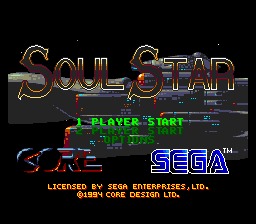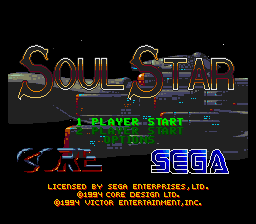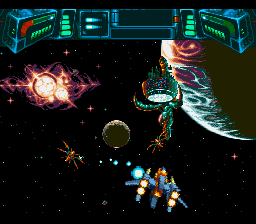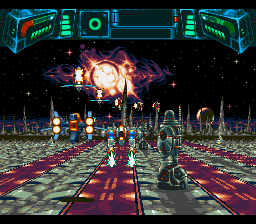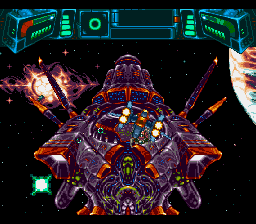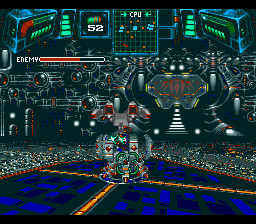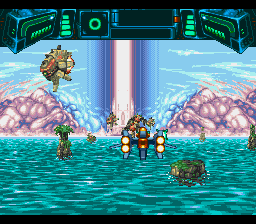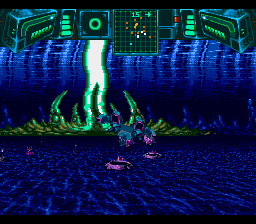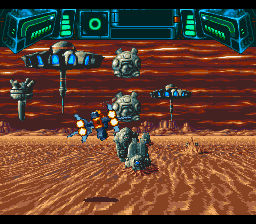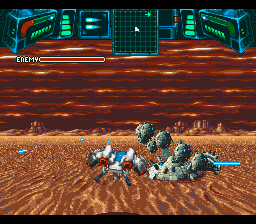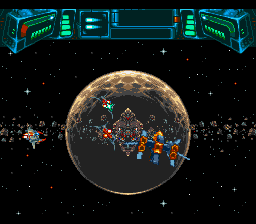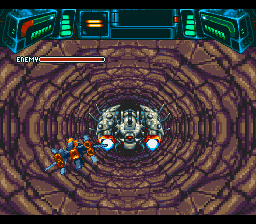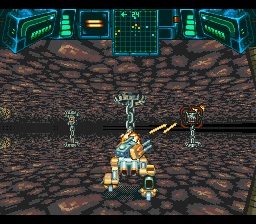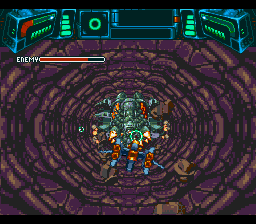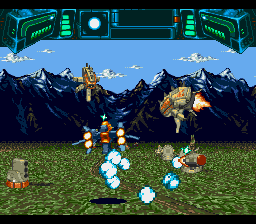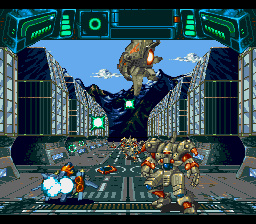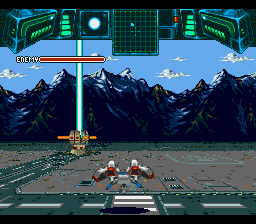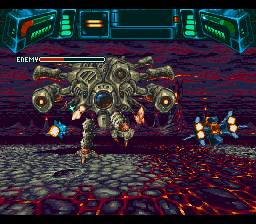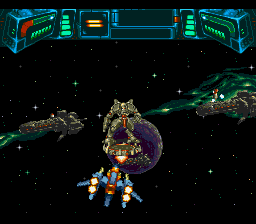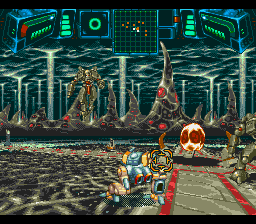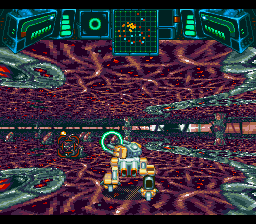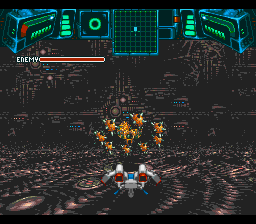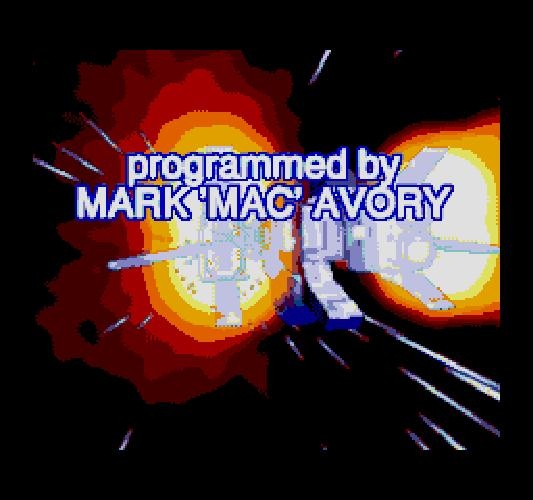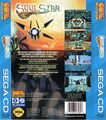Difference between revisions of "Soul Star"
From Sega Retro
| (39 intermediate revisions by 9 users not shown) | |||
| Line 1: | Line 1: | ||
{{Bob | {{Bob | ||
| bobscreen=Soulstar title.png | | bobscreen=Soulstar title.png | ||
| − | | publisher=[[Core Design]], [[Victor Entertainment]] | + | | bobscreen2=SoulStar_MCD_JP_SSTitle.png |
| + | | tab1=''Soul Star'' | ||
| + | | tab2={{MCD}}NTSC-J | ||
| + | | publisher={{company|[[Core Design]]|region=US, Europe}}, {{company|[[Victor Entertainment]]|region=Japan}} | ||
| developer=[[Core Design]] | | developer=[[Core Design]] | ||
| − | | distributor=[[Time Warner Interactive]] | + | | distributor={{company|[[Time Warner Interactive]]|region=US}}, {{company|[[Tec Toy]]|region=BR}} |
| system=[[Sega Mega-CD]] | | system=[[Sega Mega-CD]] | ||
| sounddriver= | | sounddriver= | ||
| peripherals= | | peripherals= | ||
| players=1-2 | | players=1-2 | ||
| − | | genre= | + | | genre=Shooting{{fileref|Soulstar MCD JP Box Back.jpg}}{{ref|https://web.archive.org/web/20190610175627/https://sega.jp/fb/segahard/mcd/soft_licensee.html}} |
| languages={{LanguageList|en|de|fr|jp}} | | languages={{LanguageList|en|de|fr|jp}} | ||
| releases={{releasesMCD | | releases={{releasesMCD | ||
| − | | mcd_date_jp=1994-12-22 | + | | mcd_date_jp=1994-12-22{{ref|https://web.archive.org/web/20190610175627/https://sega.jp/fb/segahard/mcd/soft_licensee.html}} |
| − | | mcd_rrp_jp=8, | + | | mcd_rrp_jp=8,000e{{magref|bemega|1995-01|11}} |
| mcd_code_jp=T-60184 | | mcd_code_jp=T-60184 | ||
| − | | mcd_date_us=1994-09{{ | + | | mcd_date_us=1994-09{{magref|egm|61|136}}{{magref|megaplay|0504|58}} |
| mcd_code_us=T-115035 | | mcd_code_us=T-115035 | ||
| − | | mcd_date_eu=1994- | + | | mcd_rating_us=ka |
| + | | mcd_date_eu=1994-10{{magref|segamaguk|10|92}} | ||
| mcd_code_eu=T-115035-50 | | mcd_code_eu=T-115035-50 | ||
| mcd_date_de=1994 | | mcd_date_de=1994 | ||
| mcd_code_de=T-115035-50 | | mcd_code_de=T-115035-50 | ||
| − | | mcd_rrp_uk=44.99{{ | + | | mcd_rating_de=6 |
| + | | mcd_date_pt=1994 | ||
| + | | mcd_code_pt= | ||
| + | | mcd_rating_pt= | ||
| + | | mcd_date_uk=1994-10{{magref|segamaguk|10|92}}<!--1994-08{{magref|segapro|36|8}}--> | ||
| + | | mcd_code_uk=T-115035-50 | ||
| + | | mcd_rrp_uk=44.99{{magref|cvg|157|100}}{{magref|megapower|10|18}} | ||
| mcd_date_br=199x | | mcd_date_br=199x | ||
| + | | mcd_code_br=062130 | ||
| + | | mcd_rating_br=ti | ||
}} | }} | ||
| − | |||
| − | |||
| − | |||
}} | }} | ||
| − | + | '''''{{PAGENAME}}''''' (ソウルスター) is a [[Sega Mega-CD]] third-person shooter developed by [[Core Design]]. The game makes heavy use of the Mega-CD's sprite-scaling capabilities to achieve a pseudo-3D effect. [[Full-motion video]] cutscenes are used for briefings, available in multiple languages for the PAL release. | |
| + | |||
| + | An upgraded [[Sega 32X]] version, known as ''[[Soul Star X]]'', was once in development but was never released. | ||
| + | |||
| + | ==Story== | ||
| + | The Myrkoids, an ancient alien species with a cold and unified mind have descended upon many star systems, stealing and draining every planet of their resources and destroying them in the process. Following the destruction of his home system, Bryk Hammelt, the last from a noble warrior race known as the Cryo-Commandos, sets out in his morphing starship, the Aggressor, to hunt down and eradicate the Myrkoids from existence, who have arrived at the Soul Star system to repeat their same process of planetary extermination. | ||
==Gameplay== | ==Gameplay== | ||
| − | + | The game is a shooter that is primarily played in a third-person perspective behind the ship. The player's ship, the Aggressor, transforms into three different types of vehicles depending on the stage. | |
| + | |||
| + | The first mode is the Sub-light Strike Craft, which controls similarly to rail shooters such as ''[[Space Harrier]]''. The ship flies through space or over a textured planetscape, while shooting upcoming enemies from the front or behind and collecting power-ups along the way. The player does not control the ship's movement through the stage but can maneuver it along the vertical and horizontal axes with the D-Pad. The Strike Craft fires its weapon with {{A}}, which can be held for rapid-fire, and switches the current weapon with {{B}}. | ||
| − | + | The second mode is the Turbo Copter hovercraft, in which players can freely roam in 360° environments akin to [[Core Design]]'s own ''[[Thunderhawk]]''. In this mode, players are tasked with eliminating primary targets within the area, which are displayed before the start of each level at the mission briefing screen. The player has a map in this mode with enemy targets and the direction of objectives marked. The Turbo Copter moves forwards and backwards with {{up}} and {{down}} and turns with {{left}} and {{right}}. It changes its altitude by holding {{C}} and pressing {{up}} or {{down}} and moves sideways by holding {{C}} and pressing {{left}} and {{right}}. The Turbo Copter fires its weapon with {{A}} and switches the current weapon with {{B}}. | |
| − | The game is | + | The third mode is the Combat Walker mecha, which controls similarly to the Turbo Copter. The player again must eliminate targets in an area and has a map to assist with locating them. The Combat Walker moves forwards and backwards with {{up}} and {{down}} and turns with {{left}} and {{right}}. It activates its thrusters, allowing it to dash forward along the ground, by holding {{B}} while pressing {{up}}. It hovers by holding {{C}}, which can be used to pass over obstacles. The Combat Walker fires its weapon with {{A}} and switches the current weapon with {{B}}. It targets its weapons automatically. |
| + | |||
| + | The Aggressor has shielding, indicated by a red strip in the top-left corner, and engine power, indicated by a green strip in the top-right corner. The ship loses shields when it takes damage from enemies, but it automatically exchanges surplus engine power for shielding, extending the life of the ship at the cost of maneuverability. The player loses a life when the ship runs out of shields. The game ends if the player runs out of lives, but it can be continued from the beginning of the current stage if the player has a continue remaining. | ||
| + | |||
| + | The game also has a two-player cooperative mode, where the first player pilots the spaceship while the second player acts as a gunner aiming at the enemies. The second player moves the targeting reticle around the screen using the D-Pad, fires with {{A}}, and switches weapons with {{B}}. The second player can transfer energy between the Aggressor's shields and engines by holding {{C}} and pressing {{left}} or {{right}}. Player two can additionally select the Torpedo weapon with {{Y}} or the Robotic Assistance Module (RAM) with {{Z}}. | ||
| + | |||
| + | ===Items=== | ||
| + | Items appear as colored spheres. Shoot at the sphere to transform it into a ring, then fly through the ring to collect the power-up. | ||
| + | {{InfoTable|imagewidths=50| | ||
| + | {{InfoRow | ||
| + | | title=Weapons | ||
| + | | sprite= | ||
| + | | desc=Red spheres give the player a special weapon, which is identified by the letter on the item in the ring. | ||
| + | }} | ||
| + | {{InfoRow | ||
| + | | title=Power | ||
| + | | sprite= | ||
| + | | desc=Green spheres increase the engine power of the ship. | ||
| + | }} | ||
| + | {{InfoRow | ||
| + | | title=Shields | ||
| + | | sprite= | ||
| + | | desc=Blue spheres replenish the shields of the ship. | ||
| + | }} | ||
| + | }} | ||
| + | ====Weapons==== | ||
| + | Some weapons have unlimited ammunition but others are limited. | ||
| + | {{InfoTable|imagewidths=50| | ||
| + | {{InfoRow | ||
| + | | title=Plasma Shot (P) | ||
| + | | bgcolor=#002a2c | ||
| + | | sprite={{sprite | Soul Star, Weapons.png | 2 | crop_width=24 | crop_height=24 | crop_x=0 | crop_y=0}} | ||
| + | | desc=Shoots plasma pulses. It has unlimited ammunition. | ||
| + | }} | ||
| + | {{InfoRow | ||
| + | | title=Ring Cannon (C) | ||
| + | | bgcolor=#002a2c | ||
| + | | sprite={{sprite | Soul Star, Weapons.png | 2 | crop_width=24 | crop_height=24 | crop_x=24 | crop_y=0}} | ||
| + | | desc=Shoots energy rings. It has unlimited ammunition. | ||
| + | }} | ||
| + | {{InfoRow | ||
| + | | title=Hunter (H) | ||
| + | | bgcolor=#002a2c | ||
| + | | sprite={{sprite | Soul Star, Weapons.png | 2 | crop_width=24 | crop_height=24 | crop_x=48 | crop_y=0}} | ||
| + | | desc=Shoots energy spheres that home in on targets. It has unlimited ammunition. | ||
| + | }} | ||
| + | {{InfoRow | ||
| + | | title=Laser (L) | ||
| + | | bgcolor=#002a2c | ||
| + | | sprite={{sprite | Soul Star, Weapons.png | 2 | crop_width=24 | crop_height=24 | crop_x=72 | crop_y=0}} | ||
| + | | desc=Shoots fast-firing lasers. It has unlimited ammunition. | ||
| + | }} | ||
| + | {{InfoRow | ||
| + | | title=Star Masher (X) | ||
| + | | bgcolor=#002a2c | ||
| + | | sprite={{sprite | Soul Star, Weapons.png | 2 | crop_width=24 | crop_height=24 | crop_x=96 | crop_y=0}} | ||
| + | | desc=Fires a charged shot that grows larger and more powerful by holding {{A}} longer before firing. It has unlimited ammunition. | ||
| + | }} | ||
| + | {{InfoRow | ||
| + | | title=Missiles (M) | ||
| + | | bgcolor=#002a2c | ||
| + | | sprite={{sprite | Soul Star, Weapons.png | 2 | crop_width=24 | crop_height=24 | crop_x=120 | crop_y=0}} | ||
| + | | desc=Shoots laser-guided missiles. It has limited ammunition. | ||
| + | }} | ||
| + | {{InfoRow | ||
| + | | title=Rockets (R) | ||
| + | | bgcolor=#002a2c | ||
| + | | sprite={{sprite | Soul Star, Weapons.png | 2 | crop_width=24 | crop_height=24 | crop_x=144 | crop_y=0}} | ||
| + | | desc=Shoots unguided rockets. It has limited ammunition. | ||
| + | }} | ||
| + | {{InfoRow | ||
| + | | title=Bombs (B) | ||
| + | | bgcolor=#002a2c | ||
| + | | sprite={{sprite | Soul Star, Weapons.png | 2 | crop_width=24 | crop_height=24 | crop_x=168 | crop_y=0}} | ||
| + | | desc=Drops bombs. It has limited ammunition. | ||
| + | }} | ||
| + | {{InfoRow | ||
| + | | title=Torpedo | ||
| + | | bgcolor=#002a2c | ||
| + | | sprite={{sprite | Soul Star, Weapons.png | 2 | crop_width=24 | crop_height=24 | crop_x=192 | crop_y=0}} | ||
| + | | desc=Attacks everything on screen when fired. One-time use. | ||
| + | }} | ||
| + | {{InfoRow | ||
| + | | title=Robotic Assist Module (RAM) | ||
| + | | bgcolor=#002a2c | ||
| + | | sprite={{sprite | Soul Star, Weapons.png | 2 | crop_width=24 | crop_height=24 | crop_x=216 | crop_y=0}} | ||
| + | | desc=Temporarily summons two drones that add support fire. One-time use. | ||
| + | }} | ||
| + | }} | ||
| + | |||
| + | ===Stages=== | ||
| + | The order of the stages depends on the difficulty level chosen. | ||
| + | {{InfoTable|imagewidths=320| | ||
| + | {{InfoRow | ||
| + | | title=Planet Leira | ||
| + | | screenshot=Soul Star, Stage 1-1.png | ||
| + | | screenshot2=Soul Star, Stage 1-2.png | ||
| + | | screenshot3=Soul Star, Stage 1-3.png | ||
| + | | tabs=yes | ||
| + | | desc= | ||
| + | }} | ||
| + | {{InfoRow | ||
| + | | title=Myrkoid Warpship | ||
| + | | screenshot=Soul Star, Stage 2.png | ||
| + | | desc=The difficulty level of the game is selected in this stage: after destroying the primary computer in the center of the stage, there are three warp gates that players can activate, each representing a difficulty level (indicated on the map at the top of the screen) and a set number of levels to go through. The player only visits every planet on Hard difficulty. | ||
| + | |||
| + | {{{!}} class="prettytable" | ||
| + | ! Easy !! Normal !! Hard | ||
| + | {{!}}- | ||
| + | {{!}} | ||
| + | *Planet Leira | ||
| + | *Myrkoid Warpship | ||
| + | *Planet Bulkan | ||
| + | *Planet Twinga | ||
| + | *Planet Gigun | ||
| + | *Myrkoid System | ||
| + | {{!}} | ||
| + | *Planet Leira | ||
| + | *Myrkoid Warpship | ||
| + | *Planet Twinga | ||
| + | *Planet Gigun | ||
| + | *Planet Bulkan | ||
| + | *Planet Guha | ||
| + | *Myrkoid System | ||
| + | {{!}} | ||
| + | *Planet Leira | ||
| + | *Myrkoid Warpship | ||
| + | *Planet Twinga | ||
| + | *Planet Guha | ||
| + | *Planet Bulkan | ||
| + | *Planet Gigun | ||
| + | *Planet Metafus | ||
| + | *Myrkoid System | ||
| + | {{!}}} | ||
| + | }} | ||
| + | {{InfoRow | ||
| + | | title=Planet Twingha | ||
| + | | screenshot=Soul Star, Stage 5-1.png | ||
| + | | screenshot2=Soul Star, Stage 5-2.png | ||
| + | | tabs=yes | ||
| + | | desc= | ||
| + | }} | ||
| + | {{InfoRow | ||
| + | | title=Planet Guha | ||
| + | | screenshot=Soul Star, Stage 3-1.png | ||
| + | | screenshot2=Soul Star, Stage 3-2.png | ||
| + | | tabs=yes | ||
| + | | desc= | ||
| + | }} | ||
| + | {{InfoRow | ||
| + | | title=Planet Bulkan | ||
| + | | screenshot=Soul Star, Stage 4-1.png | ||
| + | | screenshot2=Soul Star, Stage 4-2.png | ||
| + | | screenshot3=Soul Star, Stage 4-3.png | ||
| + | | screenshot4=Soul Star, Stage 4-4.png | ||
| + | | tabs=yes | ||
| + | | desc= | ||
| + | }} | ||
| + | {{InfoRow | ||
| + | | title=Planet Gigun | ||
| + | | screenshot=Soul Star, Stage 6-1.png | ||
| + | | screenshot2=Soul Star, Stage 6-2.png | ||
| + | | screenshot3=Soul Star, Stage 6-3.png | ||
| + | | tabs=yes | ||
| + | | desc= | ||
| + | }} | ||
| + | {{InfoRow | ||
| + | | title=Planet Metafus | ||
| + | | screenshot=Soul Star, Stage 7.png | ||
| + | | desc= | ||
| + | }} | ||
| + | {{InfoRow | ||
| + | | title=Myrkoid System | ||
| + | | screenshot=Soul Star, Stage 8-1.png | ||
| + | | screenshot2=Soul Star, Stage 8-2.png | ||
| + | | screenshot3=Soul Star, Stage 8-3.png | ||
| + | | screenshot4=Soul Star, Stage 8-4.png | ||
| + | | tabs=yes | ||
| + | | desc= | ||
| + | }} | ||
| + | }} | ||
==Production credits== | ==Production credits== | ||
| Line 41: | Line 237: | ||
*'''Programmed by:''' Mark 'Mac' Avory | *'''Programmed by:''' Mark 'Mac' Avory | ||
*'''Graphic Artist:''' Roberto Cirillo | *'''Graphic Artist:''' Roberto Cirillo | ||
| − | *'''Music & Sound FX Composed and Produced by:''' Nathan | + | *'''Music & Sound FX Composed and Produced by:''' [[Nathan McCree]] |
*'''Intro and End Sequence:''' Billy Allison | *'''Intro and End Sequence:''' Billy Allison | ||
*'''Story & Game Design:''' Roberto Cirillo, Mark Avory, Guy Miller | *'''Story & Game Design:''' Roberto Cirillo, Mark Avory, Guy Miller | ||
| Line 66: | Line 262: | ||
==Physical scans== | ==Physical scans== | ||
| − | {{ratings | + | {{ratings|MCD}} |
| − | | | ||
| − | |||
| − | |||
| − | |||
| − | |||
| − | |||
| − | |||
| − | |||
| − | |||
| − | |||
| − | |||
| − | |||
| − | |||
| − | |||
| − | |||
| − | |||
| − | |||
| − | |||
| − | |||
| − | |||
| − | |||
| − | |||
| − | |||
| − | |||
| − | |||
| − | |||
| − | |||
| − | |||
| − | |||
| − | |||
| − | |||
| − | |||
| − | }} | ||
{{Scanbox | {{Scanbox | ||
| + | | console=Mega-CD | ||
| + | | region=JP | ||
| + | | front=Soulstar MCD JP Box Front.jpg | ||
| + | | back=Soulstar MCD JP Box Back.jpg | ||
| + | | square=yes | ||
| + | | disc=Soulstar_MegaCD_JP_Disc.png | ||
| + | | manual=Soulstar_MegaCD_JP_Manual.pdf | ||
| + | }}{{Scanbox | ||
| console=Mega-CD | | console=Mega-CD | ||
| region=US | | region=US | ||
| Line 113: | Line 284: | ||
| back=Soulstar MCD EU Box Back.jpg | | back=Soulstar MCD EU Box Back.jpg | ||
| square=yes | | square=yes | ||
| − | | disc= | + | | disc=Soulstar_MCD_EU_Disc.jpg |
| spinecard=Soulstar MCD EU spinecard.jpg | | spinecard=Soulstar MCD EU spinecard.jpg | ||
| + | | manual=SoulStar MCD EU Manual.jpg | ||
}}{{Scanbox | }}{{Scanbox | ||
| console=Mega-CD | | console=Mega-CD | ||
| − | | region= | + | | region=EU (with Thunderhawk Demo) |
| − | | | + | | cover=Soulstar with thunderhawk demo MCD EU Box.jpg |
| − | |||
| square=yes | | square=yes | ||
| − | |||
}}{{Scanbox | }}{{Scanbox | ||
| console=Mega-CD | | console=Mega-CD | ||
| Line 129: | Line 299: | ||
| square=yes | | square=yes | ||
| disc=Soulstar_MCD_EU_Disc.jpg | | disc=Soulstar_MCD_EU_Disc.jpg | ||
| + | | item1=Soulstar MCD DE case sticker front.jpg | ||
| + | | item1name=Case & sticker | ||
| + | | manual=SoulStar MCD EU Manual.jpg | ||
| + | }}{{Scanbox | ||
| + | | console=Mega-CD | ||
| + | | region=PT | ||
| + | | front= | ||
| + | | back= | ||
| + | | disc= | ||
| + | | manual= | ||
}}{{Scanbox | }}{{Scanbox | ||
| console=Mega-CD | | console=Mega-CD | ||
| region=BR | | region=BR | ||
| front=SoulStar MCD BR front.jpg | | front=SoulStar MCD BR front.jpg | ||
| − | | back= | + | | back=SoulStar MCD BR Box Back.jpg |
| − | | spinemissing= | + | | spinemissing=yes |
| disc= | | disc= | ||
}} | }} | ||
==Technical information== | ==Technical information== | ||
| − | + | {{mainArticle|{{PAGENAME}}/Technical information}} | |
| − | {{ | ||
| − | {{ | ||
| − | |||
| − | |||
| − | }} | ||
==References== | ==References== | ||
<references/> | <references/> | ||
| + | |||
| + | {{SoulStarOmni}} | ||
Latest revision as of 07:11, 21 October 2024
| Soul Star | ||||||||||||||||||||||||||||||||||||||||
|---|---|---|---|---|---|---|---|---|---|---|---|---|---|---|---|---|---|---|---|---|---|---|---|---|---|---|---|---|---|---|---|---|---|---|---|---|---|---|---|---|
| System(s): Sega Mega-CD | ||||||||||||||||||||||||||||||||||||||||
| Publisher: Core Design (US, Europe), Victor Entertainment (Japan) | ||||||||||||||||||||||||||||||||||||||||
| Developer: Core Design | ||||||||||||||||||||||||||||||||||||||||
| Distributor: Time Warner Interactive (US), Tec Toy (BR) | ||||||||||||||||||||||||||||||||||||||||
| Genre: Shooting[1][2] | ||||||||||||||||||||||||||||||||||||||||
| Number of players: 1-2 | ||||||||||||||||||||||||||||||||||||||||
| Official in-game languages: | ||||||||||||||||||||||||||||||||||||||||
|
Soul Star (ソウルスター) is a Sega Mega-CD third-person shooter developed by Core Design. The game makes heavy use of the Mega-CD's sprite-scaling capabilities to achieve a pseudo-3D effect. Full-motion video cutscenes are used for briefings, available in multiple languages for the PAL release.
An upgraded Sega 32X version, known as Soul Star X, was once in development but was never released.
Contents
Story
The Myrkoids, an ancient alien species with a cold and unified mind have descended upon many star systems, stealing and draining every planet of their resources and destroying them in the process. Following the destruction of his home system, Bryk Hammelt, the last from a noble warrior race known as the Cryo-Commandos, sets out in his morphing starship, the Aggressor, to hunt down and eradicate the Myrkoids from existence, who have arrived at the Soul Star system to repeat their same process of planetary extermination.
Gameplay
The game is a shooter that is primarily played in a third-person perspective behind the ship. The player's ship, the Aggressor, transforms into three different types of vehicles depending on the stage.
The first mode is the Sub-light Strike Craft, which controls similarly to rail shooters such as Space Harrier. The ship flies through space or over a textured planetscape, while shooting upcoming enemies from the front or behind and collecting power-ups along the way. The player does not control the ship's movement through the stage but can maneuver it along the vertical and horizontal axes with the D-Pad. The Strike Craft fires its weapon with ![]() , which can be held for rapid-fire, and switches the current weapon with
, which can be held for rapid-fire, and switches the current weapon with ![]() .
.
The second mode is the Turbo Copter hovercraft, in which players can freely roam in 360° environments akin to Core Design's own Thunderhawk. In this mode, players are tasked with eliminating primary targets within the area, which are displayed before the start of each level at the mission briefing screen. The player has a map in this mode with enemy targets and the direction of objectives marked. The Turbo Copter moves forwards and backwards with ![]() and
and ![]() and turns with
and turns with ![]() and
and ![]() . It changes its altitude by holding
. It changes its altitude by holding ![]() and pressing
and pressing ![]() or
or ![]() and moves sideways by holding
and moves sideways by holding ![]() and pressing
and pressing ![]() and
and ![]() . The Turbo Copter fires its weapon with
. The Turbo Copter fires its weapon with ![]() and switches the current weapon with
and switches the current weapon with ![]() .
.
The third mode is the Combat Walker mecha, which controls similarly to the Turbo Copter. The player again must eliminate targets in an area and has a map to assist with locating them. The Combat Walker moves forwards and backwards with ![]() and
and ![]() and turns with
and turns with ![]() and
and ![]() . It activates its thrusters, allowing it to dash forward along the ground, by holding
. It activates its thrusters, allowing it to dash forward along the ground, by holding ![]() while pressing
while pressing ![]() . It hovers by holding
. It hovers by holding ![]() , which can be used to pass over obstacles. The Combat Walker fires its weapon with
, which can be used to pass over obstacles. The Combat Walker fires its weapon with ![]() and switches the current weapon with
and switches the current weapon with ![]() . It targets its weapons automatically.
. It targets its weapons automatically.
The Aggressor has shielding, indicated by a red strip in the top-left corner, and engine power, indicated by a green strip in the top-right corner. The ship loses shields when it takes damage from enemies, but it automatically exchanges surplus engine power for shielding, extending the life of the ship at the cost of maneuverability. The player loses a life when the ship runs out of shields. The game ends if the player runs out of lives, but it can be continued from the beginning of the current stage if the player has a continue remaining.
The game also has a two-player cooperative mode, where the first player pilots the spaceship while the second player acts as a gunner aiming at the enemies. The second player moves the targeting reticle around the screen using the D-Pad, fires with ![]() , and switches weapons with
, and switches weapons with ![]() . The second player can transfer energy between the Aggressor's shields and engines by holding
. The second player can transfer energy between the Aggressor's shields and engines by holding ![]() and pressing
and pressing ![]() or
or ![]() . Player two can additionally select the Torpedo weapon with
. Player two can additionally select the Torpedo weapon with ![]() or the Robotic Assistance Module (RAM) with
or the Robotic Assistance Module (RAM) with ![]() .
.
Items
Items appear as colored spheres. Shoot at the sphere to transform it into a ring, then fly through the ring to collect the power-up.
| Weapons | |
|---|---|
| Red spheres give the player a special weapon, which is identified by the letter on the item in the ring. | |
| Power | |
| Green spheres increase the engine power of the ship. | |
| Shields | |
| Blue spheres replenish the shields of the ship. |
Weapons
Some weapons have unlimited ammunition but others are limited.
Stages
The order of the stages depends on the difficulty level chosen.
| Planet Leira | ||||||
|---|---|---|---|---|---|---|
| Myrkoid Warpship | ||||||
The difficulty level of the game is selected in this stage: after destroying the primary computer in the center of the stage, there are three warp gates that players can activate, each representing a difficulty level (indicated on the map at the top of the screen) and a set number of levels to go through. The player only visits every planet on Hard difficulty.
| ||||||
| Planet Twingha | ||||||
| Planet Guha | ||||||
| Planet Bulkan | ||||||
| Planet Gigun | ||||||
| Planet Metafus | ||||||
| Myrkoid System | ||||||
Production credits
- Programmed by: Mark 'Mac' Avory
- Graphic Artist: Roberto Cirillo
- Music & Sound FX Composed and Produced by: Nathan McCree
- Intro and End Sequence: Billy Allison
- Story & Game Design: Roberto Cirillo, Mark Avory, Guy Miller
- Vocals: Yvonne Varnier, Guy Miller
- Creative Manager: Guy Miller
- Produced by: Jeremy Smith
- Producer: Toshiyuki Nagai
- Director: Gaku Sato
- Assistant: Ryo Misawa, Kohji Ishizeki
- Thanks to: Takeshi Minagawa, Takashi Kimura
- And Special Thanks to the Following Heroes...: Adrian E. Smith, Mark Price, Simon Phipps, Darren Price, Troy Horton, Jamie Morton, David Ward
Magazine articles
- Main article: Soul Star/Magazine articles.
Promotional material
- Main article: Soul Star/Promotional material.
Physical scans
| Sega Retro Average | ||||||||||||||||||||||||||||||||||||||||||||||||||||||||||||||||||||||||||||||||||||||||||||||||||||||||||||||||||||||||||||||||||||||||||||||||||||||||||
|---|---|---|---|---|---|---|---|---|---|---|---|---|---|---|---|---|---|---|---|---|---|---|---|---|---|---|---|---|---|---|---|---|---|---|---|---|---|---|---|---|---|---|---|---|---|---|---|---|---|---|---|---|---|---|---|---|---|---|---|---|---|---|---|---|---|---|---|---|---|---|---|---|---|---|---|---|---|---|---|---|---|---|---|---|---|---|---|---|---|---|---|---|---|---|---|---|---|---|---|---|---|---|---|---|---|---|---|---|---|---|---|---|---|---|---|---|---|---|---|---|---|---|---|---|---|---|---|---|---|---|---|---|---|---|---|---|---|---|---|---|---|---|---|---|---|---|---|---|---|---|---|---|---|---|
|
| 82 | |
|---|---|
| Based on 30 reviews | |
| Mega-CD, PT |
|---|
|
Technical information
- Main article: Soul Star/Technical information.
References
- ↑ File:Soulstar MCD JP Box Back.jpg
- ↑ 2.0 2.1 https://sega.jp/fb/segahard/mcd/soft_licensee.html (Wayback Machine: 2019-06-10 17:56)
- ↑ Beep! MegaDrive, "January 1995" (JP; 1994-12-08), page 11
- ↑ Electronic Gaming Monthly, "August 1994" (US; 1994-xx-xx), page 136
- ↑ Mega Play, "August 1994" (US; 1994-0x-xx), page 58
- ↑ 6.0 6.1 6.2 Sega Magazine, "October 1994" (UK; 1994-09-15), page 92
- ↑ 7.0 7.1 Computer & Video Games, "December 1994" (UK; 1994-11-15), page 100
- ↑ Mega Power, "May 1994" (UK; 1994-04-21), page 18
- ↑ File:SoulStar_MCD_JP_SSCredits.pdf
- ↑ Beep! MegaDrive, "December 1994" (JP; 1994-11-08), page 25
- ↑ Computer + Video Giochi, "Dicembre 1994" (IT; 1994-xx-xx), page 128
- ↑ Digitiser (UK) (1994-12-09)
- ↑ Edge, "January 1995" (UK; 1994-11-24), page 80
- ↑ Famitsu, "1994-12-30" (JP; 1994-12-16), page 1
- ↑ GamePro, "February 1995" (US; 199x-xx-xx), page 48
- ↑ GamesMaster, "November 1994" (UK; 1994-10-20), page 64
- ↑ Games World: The Magazine, "February 1995" (UK; 1994-12-xx), page 20
- ↑ Game Informer, "March 1995" (US; 1995-0x-xx), page 39
- ↑ Hobby Consolas, "Diciembre 1994" (ES; 1994-xx-xx), page 98
- ↑ Joypad, "3/1994" (HU; 1994-xx-xx), page 27
- ↑ MAN!AC, "12/94" (DE; 1994-11-09), page 88
- ↑ Mega, "October 1994" (UK; 1994-09-29), page 12
- ↑ Mega Force, "Février 1995" (FR; 1995-0x-xx), page 96
- ↑ Mega Fun, "12/94" (DE; 1994-11-23), page 114
- ↑ Mean Machines Sega, "November 1994" (UK; 1994-09-30), page 94
- ↑ Player One, "Décembre 1994" (FR; 1994-1x-xx), page 140
- ↑ Play Time, "1/95" (DE; 1994-12-07), page 103
- ↑ Saturn Fan, "1995 March" (JP; 1995-02-08), page 41
- ↑ Sega Magazin, "Dezember 1994" (DE; 1994-11-17), page 68
- ↑ Sega Power, "November 1994" (UK; 1994-09-29), page 52
- ↑ Sega Pro, "November 1994" (UK; 1994-10-06), page 58
- ↑ Sega Megazone, "February 1995" (AU; 1995-0x-xx), page 28
- ↑ Sega Saturn Magazine, "September 1995" (JP; 1995-08-08), page 85
- ↑ Sonic the Comic, "May 27th 1994" (UK; 1994-05-14), page 11
- ↑ Todo Sega, "Diciembre 1994" (ES; 1994-1x-xx), page 62
- ↑ Video Games, "12/94" (DE; 1994-11-23), page 34
- ↑ VideoGames, "January 1995" (US; 199x-xx-xx), page 67
| Soul Star | |
|---|---|
|
Main page | Magazine articles | Video coverage | Reception | Promotional material | Technical information
Demos: Soul Star (1994) | |
- 1-2 player games
- JP Mega-CD games
- All JP games
- US Mega-CD games
- All US games
- EU Mega-CD games
- All EU games
- DE Mega-CD games
- All DE games
- PT Mega-CD games
- All PT games
- UK Mega-CD games
- All UK games
- BR Mega-CD games
- All BR games
- Mega-CD games
- 1994 Mega-CD games
- All 1994 games
- Mega-CD shoot-'em-up games
- All shoot-'em-up games
- All games
- Soul Star
